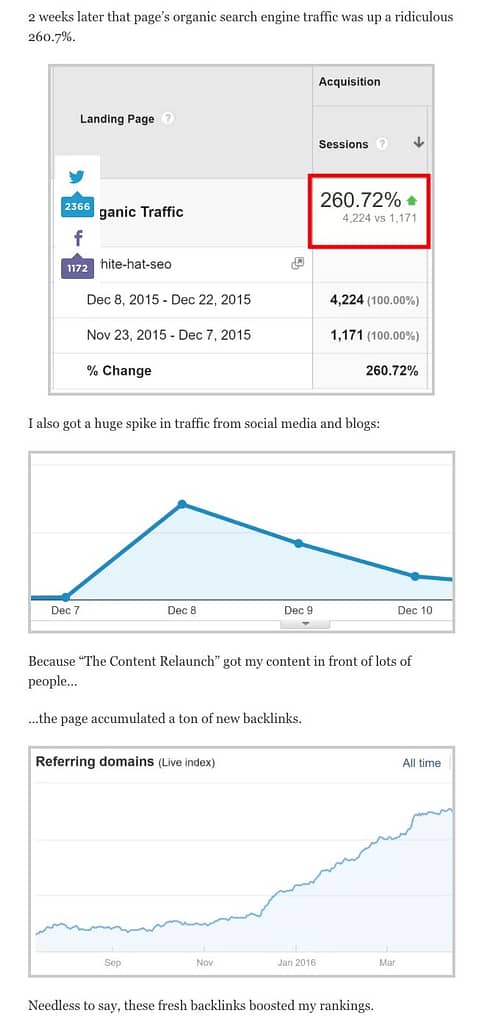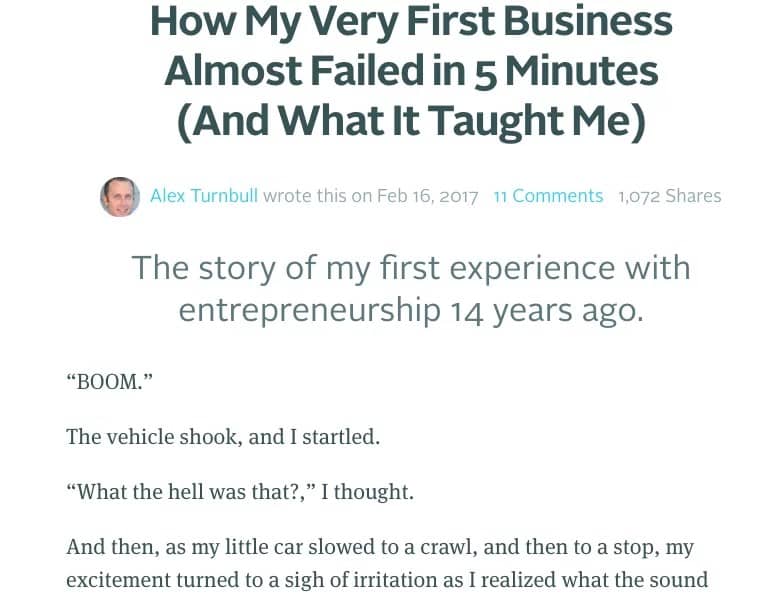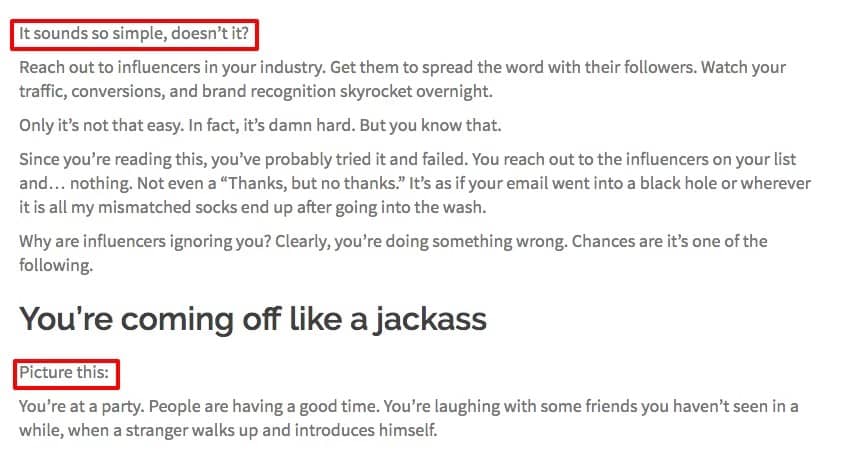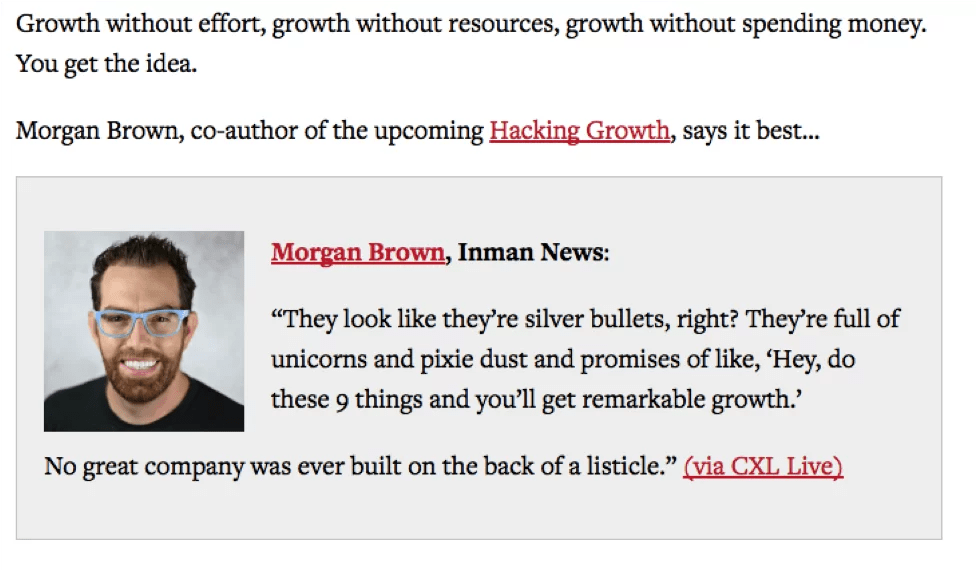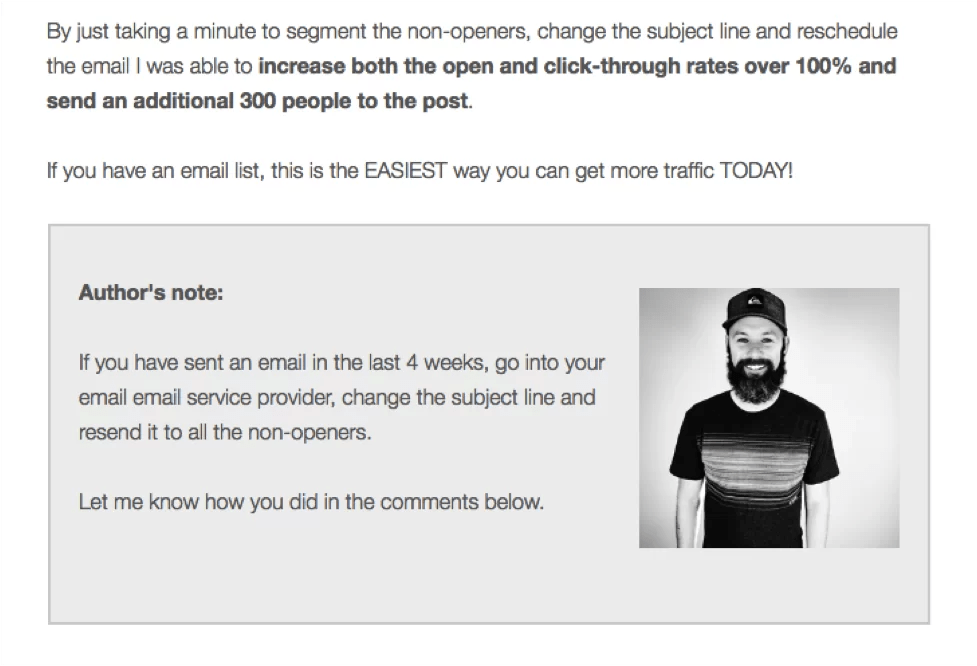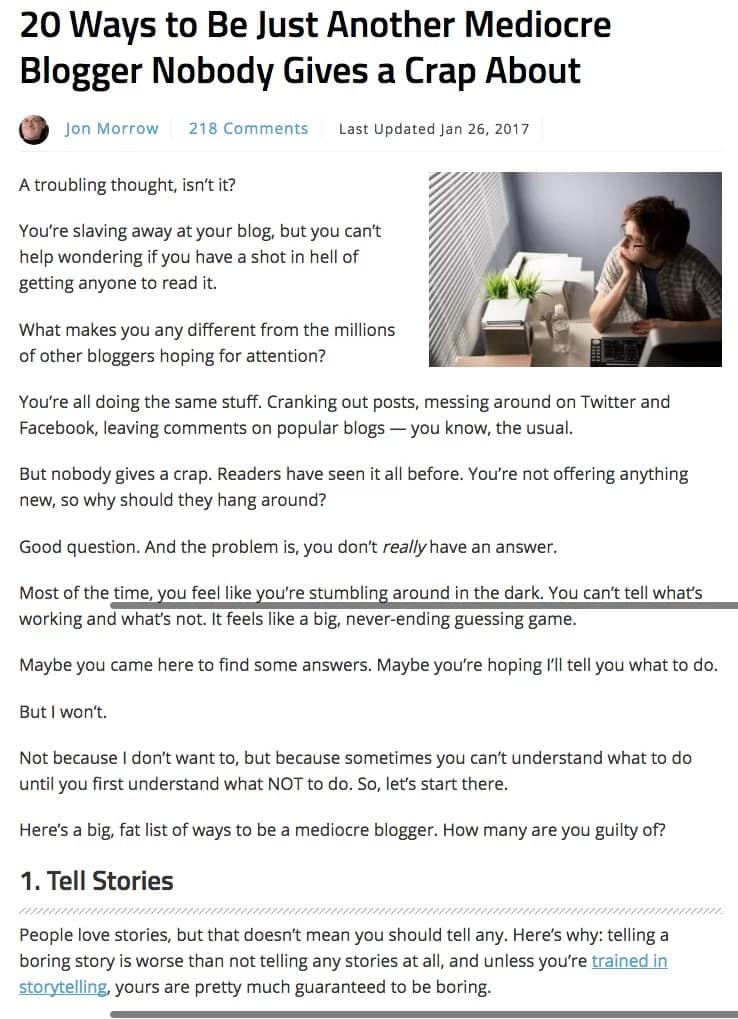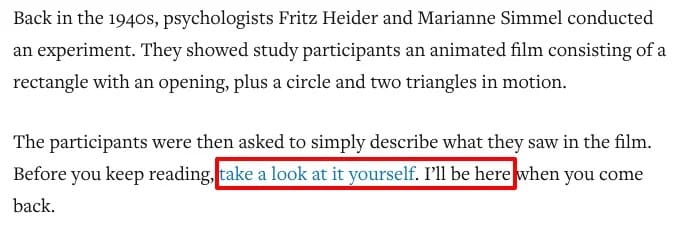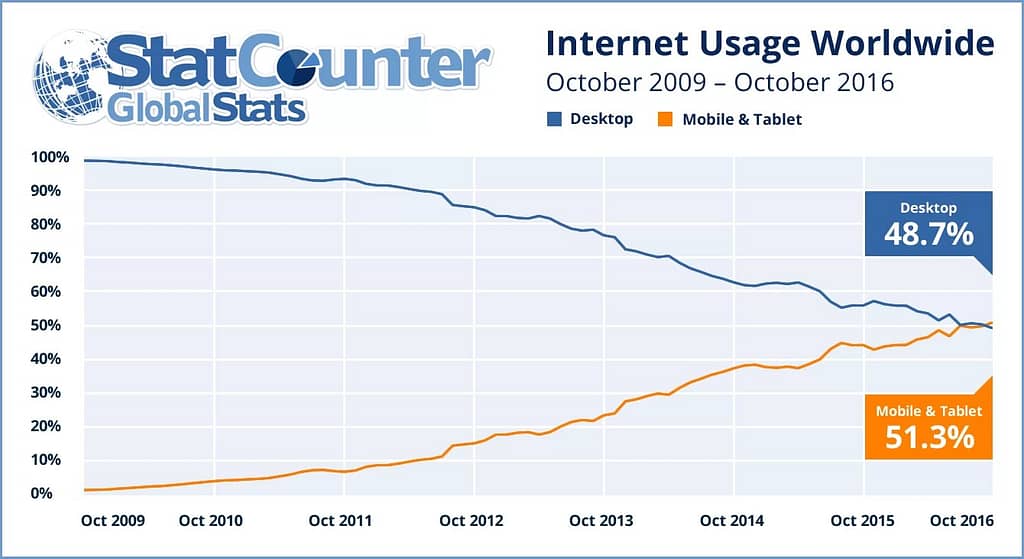It’s pretty insulting if you think about it.
You spend hours or even days pouring your soul into a blog post. And your “readers” move on with hardly a second glance.
Imagine something like that happening in the offline world. How would you feel if you spent all that time putting together a detailed report, and your boss flipped though a few pages before tossing it in the waste basket?
Now imagine that it’s not just your boss doing that, but hundreds of people. That’s what’s happening when your time on page analytics look like this:
It’s not entirely your fault. You’ve been following bad advice. In this article, I’m going to let you know what you’re doing wrong and what you should do instead.
Why you’re practically begging people to leave quickly
You’ve probably been told to make your content scannable. This is about the worst thing you can do if you want people to spend time on your page. Think about it. How long does it take you to scan an article?
Instead you want to give the perception that your content is scannable. Let me explain.
Most readers try to skim marketing content rather than investing the time to read it. They look for the points that stand out, such as subheads, callouts and images to get the gist of your article. If your reader can successfully do this, then there’s no reason to actually read it. You obviously don’t want that.
But if your article is a wall of text, it will look like too much work, and people won’t read that either.
What you need to do is give your content the appearance that it is scannable and use those elements to draw readers in.
Let’s take subheads as an example. Most articles use them to introduce a new point or section of the article. They are informational. Instead, try to treat them like headlines of their own. The goal is to get people reading the copy that follows.
When I wrote this article about ways to get more mileage out of existing content, I could have used subheads like:
Syndicate articles on other websites
Repurpose content for other formats
Instead, I crafted these messages that tease a benefit:
Get published on multiple sites without guest blogging
Double your content creation in half the time (or less)
See the difference? The first set of subheads gives the story away. The second set piques your interest and you can’t help but read on.
Take a similar approach with your images, captions and callouts. The job of each is to get people to start reading. Don’t you want to dive into the article to find out how Brian Dean accomplished the results shown in these charts?
The opportunity most blogs miss
Your content can be like a magnet. If it’s compelling and valuable, it attracts readers and makes them stick. But magnets have another side that repels objects with the same magnetic pole. That’s the side most blog posts start with.
How often have you seen an article that begins like this?
Or this one?
These examples push readers away before they even have a chance to get into the article. People’s attention spans are minuscule these days, and you only have a few seconds to grab them.
But when you do, you can suck them in before they realize what’s happening. That’s why I often spend more time on the introduction than any other area, even the headline.
Here are a few ways to make your opening magnetic:
Make an emotional connection. Take a look at the intro to this article you’re reading now. Can’t you just feel the frustration, and perhaps a little bit of anger, build? Didn’t that emotional investment make you want to continue on? You don’t want to walk away feeling like that.
Anger and frustration aren’t the only powerful emotions you can use. Fear, greed, envy, guilt, pride, love and hope can all be used to engage readers from the get-go.
Tell a story. Facts and figures are boring. They are easily forgotten. But stories can bring information to life. We can visualize them in our minds’ eye. We can relate to them. We feel empathy for the people in them.
Tell me you don’t get sucked into Alex Turnbull’s story on how his first business almost failed before it even got started in this article:
Build curiosity. Remember, your objective is keep people reading. Adding a little mystery or suspense is one of the best ways to this. I’ll share some specific tactics and examples for this a little later because it applies to more than just the intro.
Make your first paragraph short. Your introduction is the main entry point to your article. It’s vital to eliminate barriers at this point, including long text.
Which of these would you rather read?
How the world’s best blog writers keep people reading
The intro isn’t the only place you can lose readers. You need to keep their attention throughout the article. Bad advice causes problems here, too.
You see the data that long-form content performs better than shorter content. And it makes sense. More content takes longer to read, so your time on page should go up. But that’s only true if people read the whole thing.
By focusing on length rather than value, you increase your risk of pushing readers away. So what you leave out is as important as what you put in. Take this article for instance.
Many writers would have included a section in the beginning about the benefits of keeping people reading your article. But you already know the benefits. Otherwise you wouldn’t have started reading this article in the first place.
What you want is to learn how to do it. You want strategies and tactics you can put to use. So instead of telling you things you already know, I delve right into the good stuff and don’t let up until you reach the end.
Unfortunately, providing helpful information is not enough to hold attention today. You have to build intrigue. That’s where these tactics come in.
Grease Slide Copy
The end of a paragraph. The conclusion of a thought or message. A definitive statement. There are several natural stopping points throughout every article. These call for grease slide copy.
These phrases go by several names. Brian Dean calls them bucket brigades. Joseph Sugarman refers to them as seeds of curiosity. No matter what you call them, they are a great way to move readers through your content.
They do two things:
First, they build anticipation by delaying the information ever so slightly. In fact, the sentence above is a good example. You want to know what those two things are, so you are compelled to keep reading.
Second, they provide a bridge from one paragraph or message to another. Look at these examples from one of my articles:
Notice how you slide effortlessly to the next paragraph?
Here are a few other words and phrases to try:
- Why?
- Let me guess
- Be honest
- Admit it
- Listen:
- Get this:
- Then it hit me
- Or is it?
- Let me explain
- Here’s why
- Here’s the thing
- Here’s the best part
- You’re probably thinking…
Insert one of these phrases anywhere people may lose interest or feel like pausing.
Open loops
Remember when I introduced the idea of building curiosity in the section about your introduction? That is an example of an open loop, and this is where I’m paying it off. You had to keep reading if you wanted to get these.
And that desire is fueled by more than just the value of the information. We’re wired to seek closure. Open loops actually cause anxiety that is only satisfied by closing the loop.
This is one the tactics TV shows use to get you to binge-watch. You sit down planning to view a single episode. But the cliffhanger at the end is too compelling to wait. So start the next episode. And then the next. And so on.
There’s no reason you can’t do the same thing in your writing.
Here’s an example from Larry Kim.
The phrase “start with the bad news,” signals that there is good news to follow. You have to read on to find it.
Pattern interrupts
Have you ever found yourself driving around without even thinking about where you are going? You turn down a road almost through muscle memory because you’re so used to the route. That’s your subconscious mind following a pattern.
The same thing can happen with your content.
Readers expect paragraphs to follow paragraphs and on. This familiar pattern allows the brain to go on autopilot. You don’t want this. You want readers’ attention.
Break the pattern by adding testimonials, sidebars, callouts and other devices that temporarily interrupt the narrative of your text like these examples.
Pattern interrupts aren’t limited to visual elements, though. Use unexpected messaging to break the patterns that make your content predicable and boring. This could be taking a controversial view, using a tone that doesn’t quite fit the ordinary fare, or suddenly changing pace.
Take a look at how Jon Morrow uses pattern interrupts to engage readers in this popular post.
It starts right with the headline. Being a mediocre blogger is not what you’d expect in a “how to” article. That’s not what people strive for. As a result, it gets your attention and piques your curiosity. Compare that to a more traditional headline like, “How to be a successful blogger.”
Morrow continues to interrupt what you’d expect to read throughout the article. Take the section on storytelling. How many times have you heard that you need to tell stories? So when you read that you shouldn’t, you just have to learn why.
Involvement devices
The more your readers feel like active participants, the more they become engaged. In most articles, you can’t use devices that physically involve readers. But you can involve them mentally. Here are three ways:
- Ask questions. When someone asks you a question, your brain automatically starts searching for an answer. It’s an involuntary reaction. And you can use that to your advantage.
Pepper questions throughout your articles to get readers to inject themselves into the narrative. Try these for starters:
Which would you rather…
Have you ever…
What would you do if…
-
- Get readers to insert themselves in your article. Use phrases such as “imagine” or “picture” to introduce hypothetical scenarios starring the reader. Paint the picture with your words. That’s what I did in the introduction to this article when I asked you to imagine your boss tossing your report in the trash with nary a second glance.
- Get readers to insert themselves in your article. Use phrases such as “imagine” or “picture” to introduce hypothetical scenarios starring the reader. Paint the picture with your words. That’s what I did in the introduction to this article when I asked you to imagine your boss tossing your report in the trash with nary a second glance.
-
-
-
- Assign a simple task to demonstrate a point. That’s what Brian Clark does in this article on storytelling.
-
-
The final ingredient to content that keeps people reading
Last, but not least. Don’t forget or underestimate the importance of writing well. All of the tips and tricks won’t do a lick of good if your writing is convoluted, verbose or just plain boring. Those are all barriers most readers won’t work to overcome.
Make your content easy to read. Use mostly short sentences and paragraphs. They are easier to read, especially on smartphones. That’s more important than ever now that more people access the internet on a mobile device than a desktop or laptop.
Also choose simple words and phrases whenever possible. Our brains can process this information more easily. If someone has to re-read a section, they may just as easily give up.
Short paragraphs are also easier to read on smartphones. That’s vital since more people now access the internet on the phone than desktop.
Tools like Hemingwayapp.com can help you calculate reading level and see where you can simplify your messaging.
Write the way your target audience speaks. Think about it this way:
Would you rather sit through an academic lecture or engage in a conversation with a friend?
You want your article to feel more like the latter. Ditch the formal language. Feel free to bend or even break some grammar rules if it helps you sound more conversational. Compare these sentences:
“Who are you writing your article for?”
“For whom are you writing your article?”
The former is bad grammar. You’re not supposed to end sentences in a preposition. But the proper English sentence sounds too stiff. It’s not how people speak, so it distracts us from the message. In this case, the bad grammar is more effective.
Jargon is a bit tricky. Sometimes these words help your writing. For instance, if you tried to avoid using terms like SERP in an article for SEOs, you wouldn’t sound like a credible source. That jargon is conversational for this audience. But other times, jargon can kill your writing.
A sentence like “This enterprise-wide solution enables you to reconceptualize big data within your blue ocean strategy,” is likely to get only eye rolls.
So how do you decide which jargon to use and which to leave out?
If it’s something your audience would use in conversations when they aren’t trying to impress anyone, go ahead and use it. If not, rewrite your sentence.
Use images and examples. People process images faster than words. Don’t believe me? Look below and tell me which you comprehend more quickly.
It makes sense when you think about it. The brain will translate the text into a visual whenever possible. If I tell you to think about a car, you imagine an image not the letters c-a-r.
Of course you can’t use images to convey everything. That’s why you need to choose wording that helps readers form images in their minds. That’s what examples do.
For instance, the definition of irony is:
(1) : incongruity between the actual result of a sequence of events and the normal or expected result (2) : an event or result marked by such incongruity
And here’s an example of irony:
A billboard promoting public school has a spelling error. (This really happened, by the way. Check out the image here.
Which one helps you understand the concept better? Most would agree that it’s the example. Unlike the abstract definition, you can visualize the example.
Conclusion
I’m not fool enough to say that people will read every word of your articles if you follow my advice. But I’m confident they won’t pogostick either.
Getting people to engage with you for even a few minutes more can open the door to a world of possibilities.
And you won’t have to mutter anything about those ungrateful (insert your favorite insulting name here) any more.




